Dilyara Kaipova: Re-invention of Ikat Tradition
August 27, 2021
“I sincerely believe that traditional folk art in Uzbekistan, of which there are many types, is not frozen or canonical, it is a living organism that develops according to its own laws. We can not influence, preserve or protect it, we can not control it. We are fond of talking about “preserving traditions” or about the “purity of tradition,” which in my opinion is absurd. I am always trying to add irony to my work, I think it is easier to communicate some important topics in that way.” – Dilyara Kaipova.
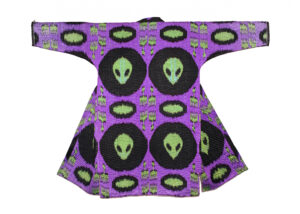
Dilyara Kaipova, Alien Invaders Robe, 2018. Ikat cotton fabric designed by the artist and handmade in collaboration with a weaving workshop in Margilan, Uzbekistan.
Spotlight on Kaipova’s work from Sapar Contemporary:
All of the fabrics are made in the city of Margilan, Uzbekistan, using ancient techniques. Almost the entire production cycle is manual. These textile workshops are most often small family enterprises. Dilyara lives in the city of Tashkent, the capital of Uzbekistan, which does not have a textile tradition. She travels to Margilan where she works with the craftsmen who make fabrics according to her designs. Dilyara funds for all of the work, including many unsuccessful fabrics, because she considers many of her designs experimental and she knows that the final result is always unpredictable. Some designs cannot be produced, no matter how hard she and the Ikat masters try. The artist designs the patterns of fabrics but never interferes in the production process. She does however, carefully study the whole process because the technology has many advantages and also limitations, and without fully understanding the production process Dilyara says she would not be able to innovate.
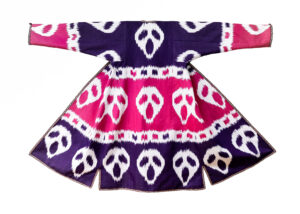
Dilyara Kaipova, Scream, 2020. Traditional female robe munisak, 50% silk, 50% cotton.
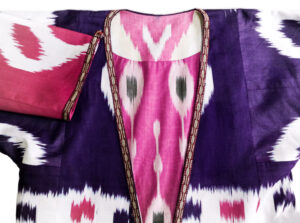
Dilyara Kaipova, Scream (detail), 2020. Traditional female robe munisak, 50% silk, 50% cotton.
Why “Scream” and “Superheroes”? Dilyara’s goal was to organically insert minimalistic, easily recognizable fashion logos and signs of pop culture into the Ikat ornament, to mix these incompatible visual traditions. She chose the most recognizable ones–including the mask from Scream, Micky Mouse, and Darth Vader. These images are not only different in style from Uzbek folk patterns, they belong to cultures that are very distant from each other. Dilyara thinks of them as being from different planets–Uzbekistan and America or Europe. And of course, the proliferation and mixing of these visual traditions is the product of globalization. Dilyara sometimes keeps track of how many images of SpongeBob or Spider-Man she sees everyday–on T-shirts or other clothes, on food packages, in the most unexpected places. She observes people who walk around in T-shirts with prints of superheroes or logos of famous luxury brands–ironically these are mostly Chinese or local fakes. Last year the Gucci stripes were everywhere in Central Asia and Dilyara is in the process of creating her own interpretation of the Gucci craze–an Ikat fabric with the famous red and green stripes. Plastic “Scream” masks are very popular during New Year holiday celebrations and the film Scream is also well-known in the region, although Dilyara also relates this images to Edvard Munch.
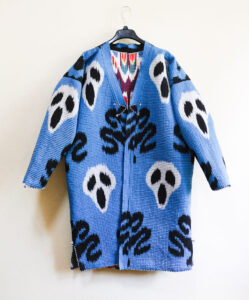
Dilyara Kaipova, Blue Scream II, 2020. Handmade quilted robe.
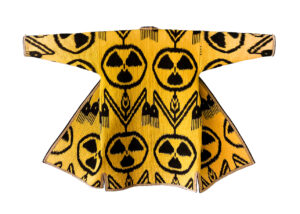
Dilyara Kaipova, Kremlin, 2021.
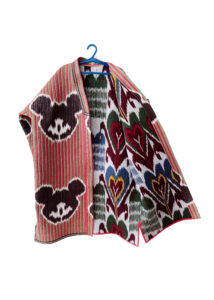
Dilyara Kaipova, Mickey Maus Robe, 2021.
The “Danger Sings” fabric was made at the end of 2017. Dilyara says many people questioned whether the nuclear danger theme is relevant for Uzbekistan. Since she grew up in the USSR, she remembers constantly being told about the nuclear threat from the West, even at an early age. There was also Chernobyl and rocket launch facility in a neighboring Kazakhstan. In 2018 Uzbekistan and Russia have singed an agreement for the construction of a nuclear power plant in Uzbekistan. The symbol itself, Dilyara saw on an old traditional embroidery and then on a photograph of vintage embroideries. She was surprised that it was the same–black on a yellow background and and inscribed circle.
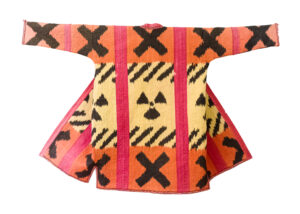
Dilyara Kaipova, Danger Signs, 2020. Natural and synthetic dyes, hand-dyed cotton quilted robe.
—Dilyara Kaipova (Tashkent, 1967) works with Uzbek textiles, reviving its centuries-long traditions, to make this medium relevant to current socio-cultural and ecological problems of the region and its post-modern history. Kaipova’s practice is located at the interaction of folk artisan traditions and contemporaneity. The artist designs original patterns and produces her ikat fabrics in collaboration with traditional masters. She also sources and uses vintage fabrics and embroideries–local fabrics of the Soviet period and ‘naive’ homemade embroideries. Kaipova’s textile work was first shown in Tashkent in 2016 and since then has been displayed in exhibitions in Kyrgyzstan, Russia, Georgia and the UAE.


Related Blog Articles
No related blog articles yet.